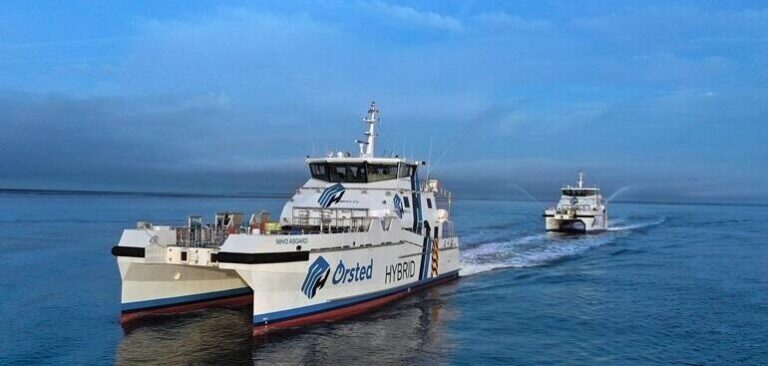Two new hybrid crew transfer vessels (CTVs) – MHO Asgard and MHO Apollo – have arrived at operator MHO-Co’s headquarters in Esbjerg, Denmark, after making the 12,000 nautical mile journey from China’s AFAI Southern Shipyard. Measuring 34.4m in length and with an 11m beam, the vessels will be run by MHO-Co and service the Hornsea Two offshore wind farm in the North Sea.
The vessels’ power system is the result of a collaboration between Volvo Penta and Danfoss Editron. The companies have developed a fully integrated solution made up of a Danfoss Editron electric drivetrain supported by Volvo Penta variable-speed gensets that drive two of the first electric Volvo Penta Inboard Performance System (IPS) units as well as two D13 Penta IPS units. According to the manufacturer, the new IPS units have already achieved 1,000 hours of operation before reaching the customer. This impressive mileage has given all the teams time to test and adjust the system to create a tailor-made solution that fits the owner’s requirements.
“These systems are a very important first step toward the future of sustainable operations at sea,” said Mik Henriksen, CEO of MHO-Co. “We believe it is our shared responsibility to drive more sustainable solutions in the marine sector, and the best way to do this is through collaboration.”
Danfoss Editron and Volvo Penta treated the journey from China to Denmark as a pilot project and a time to work with the captains and crew to tweak the technology on board to make it as reliable and efficient as possible. The companies say they were able to test different power combinations, such as diesel-electric operation or diesel-only. In dynamic positioning system mode (DPS mode) fuel consumption is below 20 l/h. and can be as low as 17 l/h.
Volvo Penta says it also worked with captains during the design phase to reimagine existing systems. For example, to take the electric propulsion dimension into account, it created a completely new HMI. “The design, build and delivery of these vessels was all about teamwork and collaboration,” explained Erno Tenhunen, Danfoss Editron’s marine director. “Ultimately, these are learning projects on all sides. We are trying to push the limits of technology, and the best way to do this is to bring our unique ideas, perspective and knowledge together. That’s exactly what we have done here.”
Before the vessels enter operation, batteries are being installed in Denmark to provide stored power for zero-emission operation. This system will allow the vessels to operate in zero-emission electric mode for up to eight hours or, in combination with diesel propulsion, to achieve a maximum speed of approximately 24kts. Using multiple modular generators allows operators to tailor power generation to the operational profile and enhance flexibility.



